
Galium boreale or northern bedstraw is a perennial plant species of the Rubiaceae family. It is widespread over the temperate and subarctic regions of Europe, Asia and North America including most of Canada and the northern United States.

Eleocharis is a virtually cosmopolitan genus of 250 or more species of flowering plants in the sedge family, Cyperaceae. The name is derived from the Greek words ἕλειος (heleios), meaning "marsh dweller," and χάρις (charis), meaning "grace." Members of the genus are known commonly as spikerushes or spikesedges. The genus has a geographically cosmopolitan distribution, with centers of diversity in the Amazon Rainforest and adjacent eastern slopes of the South American Andes, northern Australia, eastern North America, California, Southern Africa, and subtropical Asia. The vast majority of Eleocharis species grow in aquatic or mesic habitats from sea level to higher than 5,000 meters in elevation.
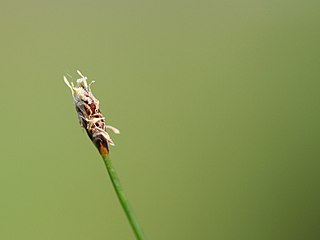
Eleocharis acicularis is a species of spikesedge known by the common names needle spikerush and least spikerush. It is widespread across Europe, central and southeastern Asia, North America and northeastern South America as far south as Ecuador. It is also found in Australia, where it is probably an introduced species.
Eleocharis atropurpurea is a species of spikesedge known by the common name purple spikerush. This is an aquatic plant native to much of. It also has a wide distribution in temperate regions of North and South America and Asia. It is present in Europe, where it may be an introduced species for the most part.
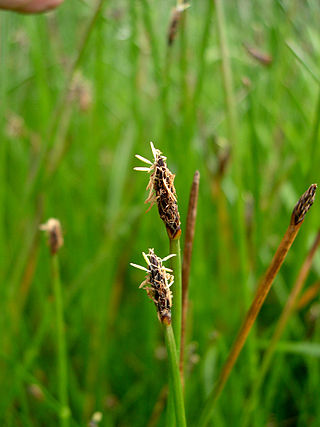
Eleocharis macrostachya is a species of spikesedge known by the common name pale spikerush.

Eleocharis quinqueflora is a species of spikesedge known by the common names fewflower spikerush and few-flowered spike-rush. It is widespread across Europe, North Africa, northern Asia, and North America. There are also isolated populations in Argentina and Chile.

Eleocharis palustris, the common spike-rush, creeping spike-rush or marsh spike-rush, is a species of mat-forming perennial flowering plants in the sedge family Cyperaceae. It grows in wetlands in Europe, North Africa, northern and central Asia and North America. Eleocharis palustris is not easily distinguished from other closely related species and is extremely variable worldwide itself. The species epithet palustris is Latin for "of the marsh" and indicates its common habitat.
Eleocharis montevidensis is a species of spikesedge known by the common name sand spikerush. It is a widespread coastal plant native to the Americas. It grows in moist, sandy spots in many habitat types, including lakes, riverbanks, wet meadows, and springs. It has a disjunct distribution, in North America and South America.

Eleocharis parishii is a species of spikesedge known by the common name Parish's spikerush.

Eleocharis parvula is a species of spikesedge known by the common names dwarf spikerush, small spikerush and hairgrass in aquaria. It is a plant of brackish and saltwater habitat, such as marshes and mudflats. It is a perennial herb growing tufts of spongy, compressible stems not more than 10 centimeters tall. The plant grows from a tuber which is J-shaped or horseshoe-shaped, a characteristic that helps in the identification of the species. The inflorescence is an oval-shaped spikelet just 2 or 3 millimeters long, made up of several tiny flowers.

Eleocharis quadrangulata is a species of spikesedge known by the common names square-stem spikerush and four-angled spikerush. It is native to eastern and central North America, with additional populations in California, Oregon, and west-central Mexico. It grows in and around freshwater in lakes, ponds, and other bodies of water. It is a rhizomatous perennial herb growing one half to one meter in height. The spongy, compressible stem is a few millimeters wide and sharply four-angled. The inflorescence is a single spikelet 1.5 to 7.5 centimeters long which is made up of several flowers covered in light brown bracts.

Eleocharis rostellata is a species of spikesedge known by the common name beaked spikerush. It is widespread across North America, with isolated populations in Argentina.

Coleanthus is a genus of Eurasian and North American plants in the grass family. The only known species is Coleanthus subtilis. It has a scattered distribution, found on lakeshores, streambanks, and other wet places in central Europe, Asia, and northwestern North America.

Tripogon is a genus of tropical and subtropical plants in the grass family. They are widespread across Asia, Africa, Australia, and the Americas. Fiveminute grass is a common name for plants in this genus.
Eleocharis tuberculosa, the cone-cup spikerush, is a plant species native to the United States and Canada. It has been reported from every state on the Gulf and Atlantic coasts from Maine to Texas, plus Kentucky, Tennessee, Arkansas and Nova Scotia. It is found in wet soil in meadows, woodlands, lake shores and river banks.
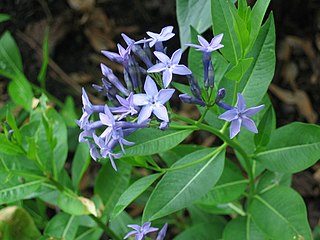
Amsonia orientalis, the European bluestar, is a species of flower in the dogbane family. It is found in European Turkey, and may be extirpated from Greece. Other historical populations appear to be lost. It is threatened by habitat loss, collection for ornamental use, and over-harvesting for research. It contains many glycosides and glycoalkaloids, and also has broad antimicrobial activity.
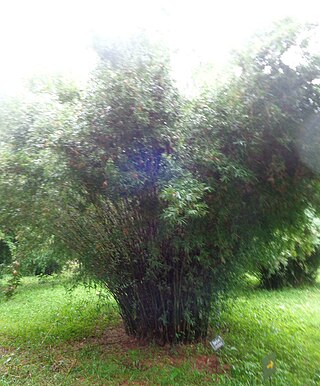
Bambusa multiplex is a species of bamboo native to China, Nepal, Bhutan, Assam, Sri Lanka, Taiwan, and northern Indochina. It is also naturalized in Japan, Iraq, Madagascar, Mauritius, Seychelles, the Indian subcontinent, parts of South America, the West Indies, and the southeastern United States.
Veronica brownii is a plant belonging to the family Plantaginaceae native to New South Wales in Australia, where it is restricted to the Blue Mountains. It has arching branches with variable shaped leaves and lilac flowers in spring and summer.
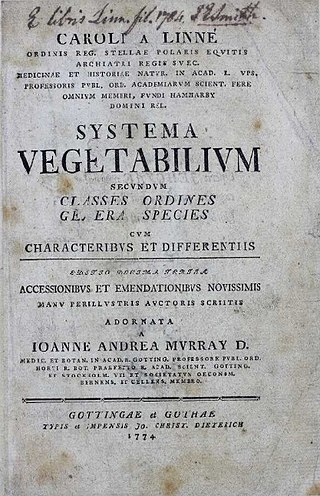
Systema Vegetabilium is a book published in four editions, following twelve earlier editions known as Systema Naturae. The first edition, published in 1774 and edited by Johan Andreas Murray is counted as edition 13 because it continues from the 12th edition of Systema Naturae. All the names in it are attributed to Carl Linnaeus. The second edition, published in 1784, includes plant species described by J.A. Murray and Carl Peter Thunberg. The third edition, was edited by Christiaan Hendrik Persoon

Schoenus pedicellatus is a species in family Cyperaceae, first described by Robert Brown in 1810 as Chaetospora pedicellata, but assigned to the genus, Schoenus, in 1811 by Jean Louis Marie Poiret. Note that GBIF and Plants of the World Online both give the genus change as being by Roem. & Schult. However the species is Australian and the text by Poiret is earlier than that of Roemer and Schultes.















